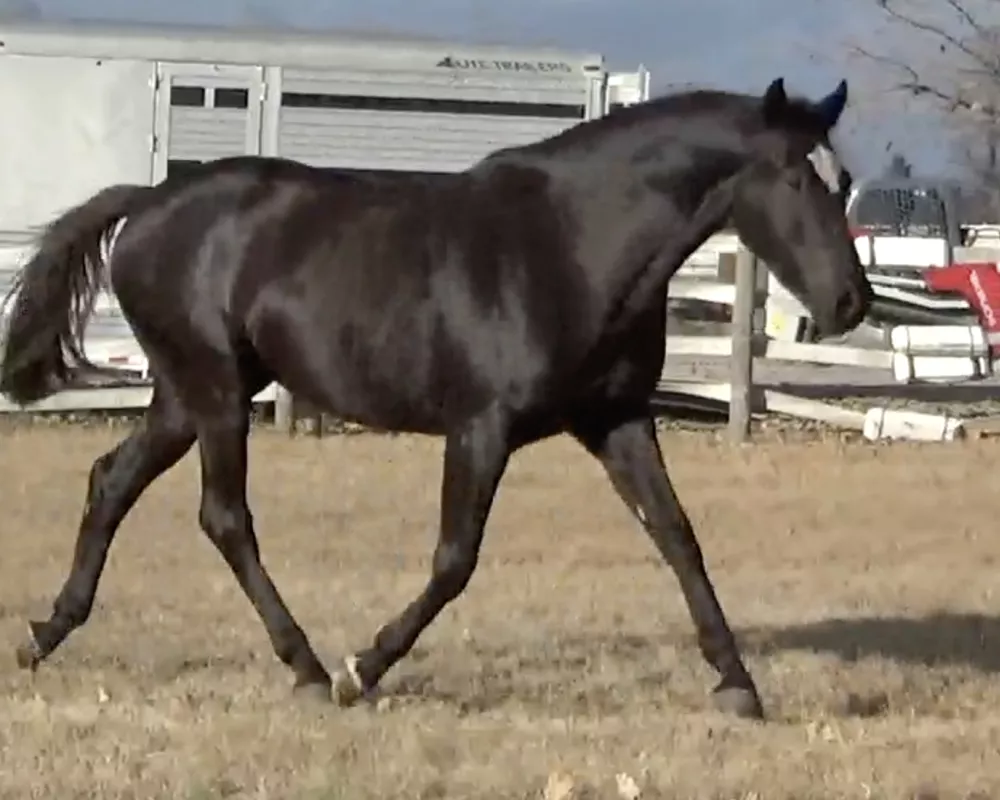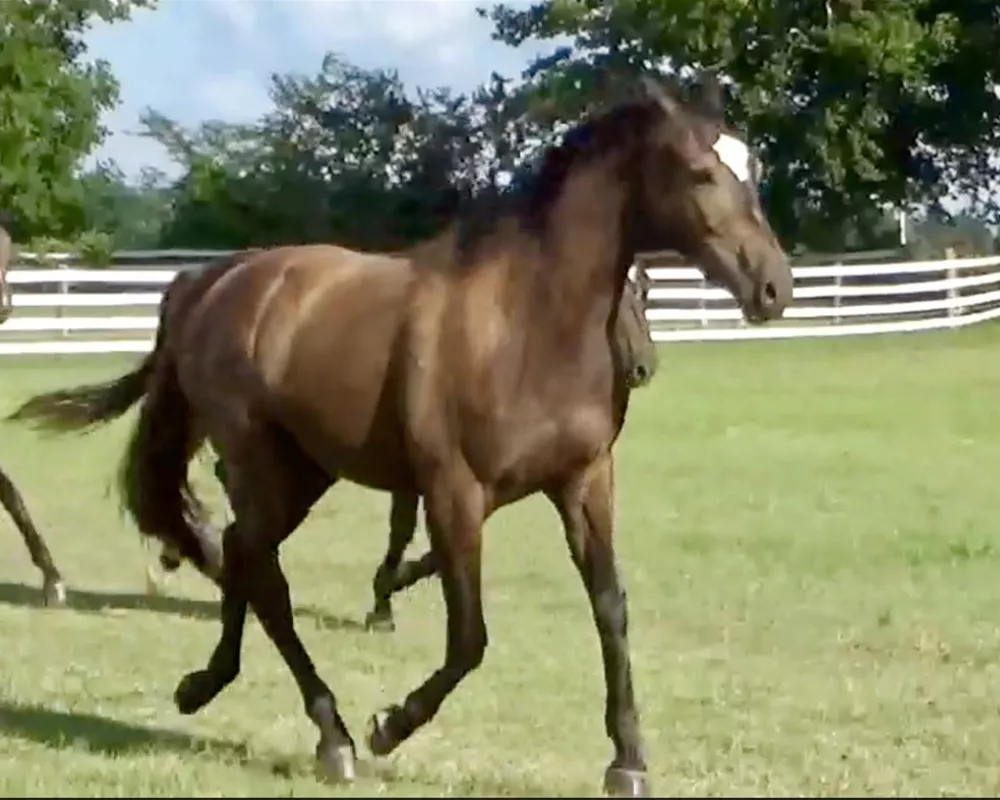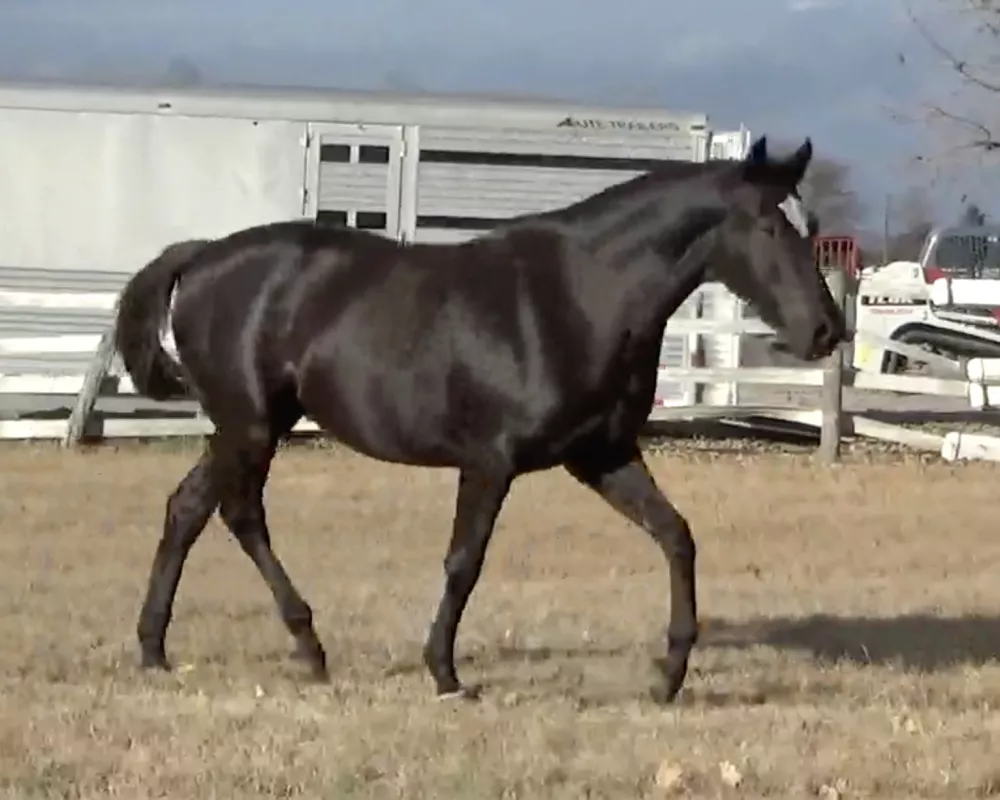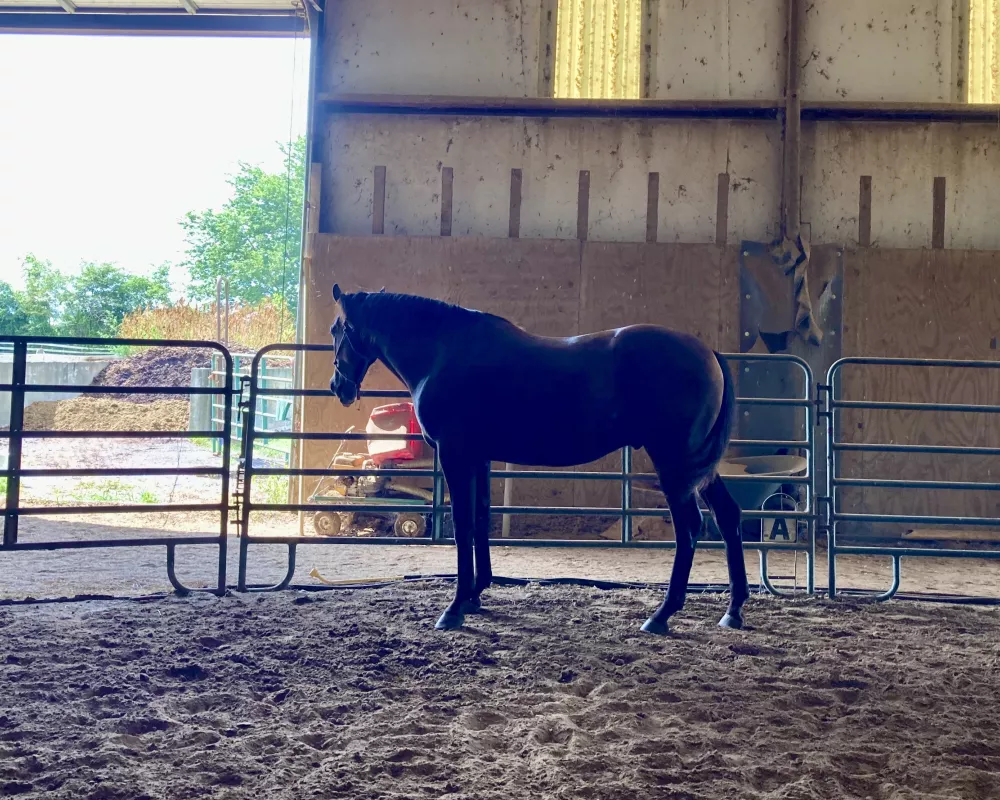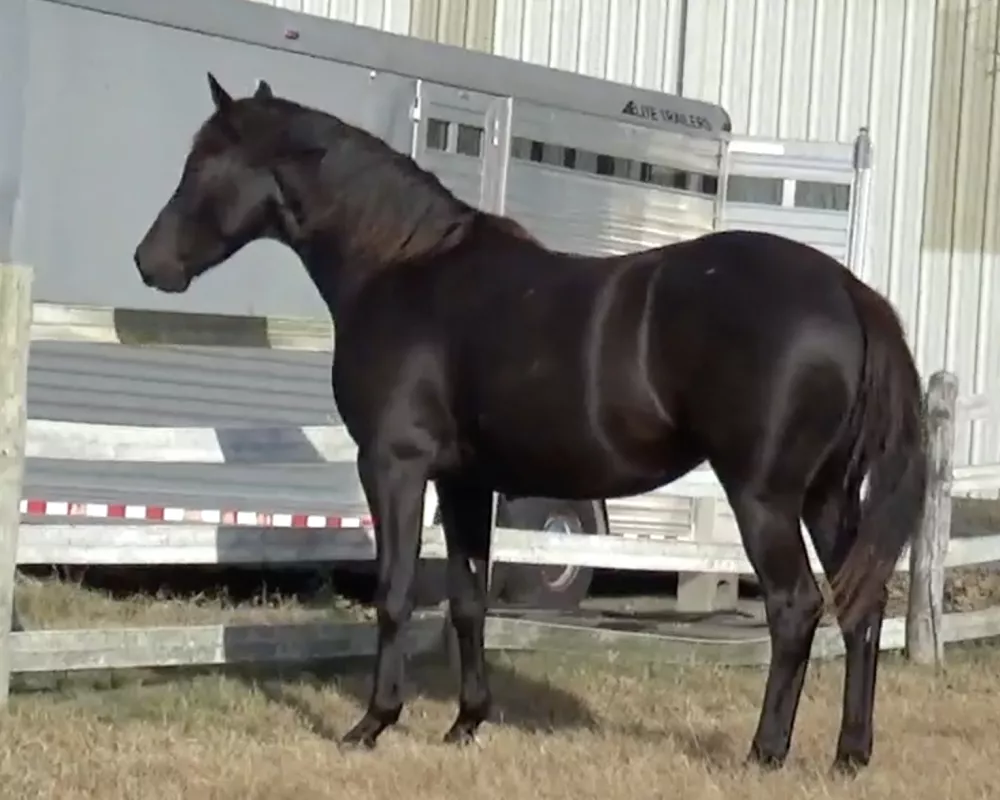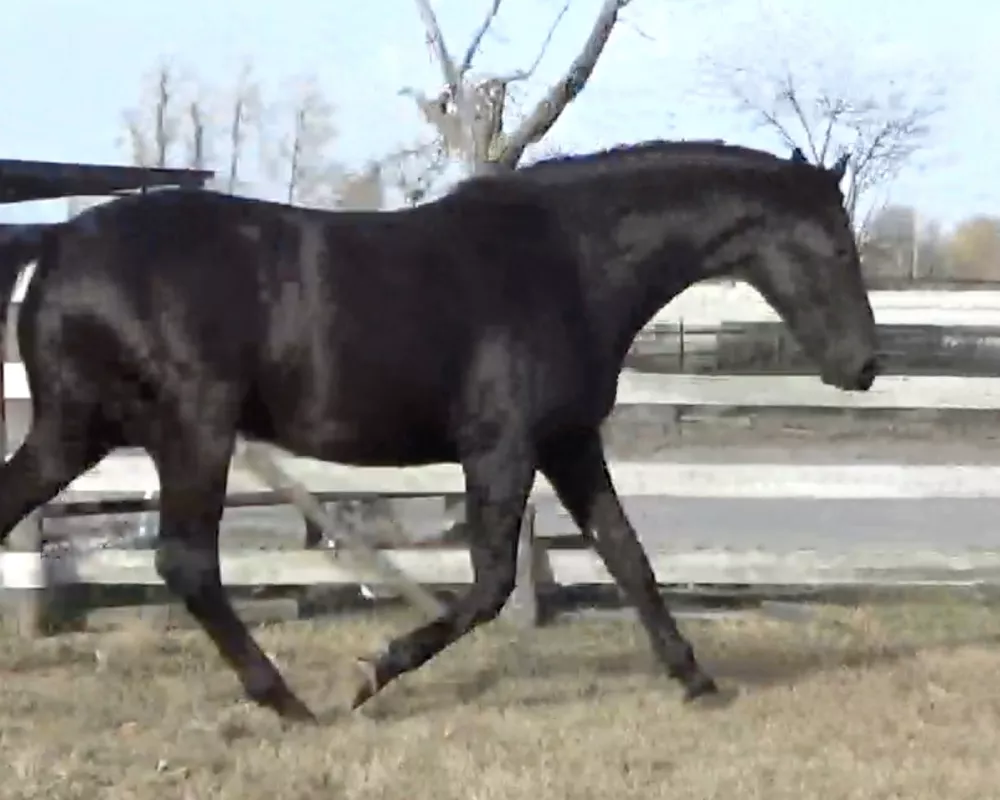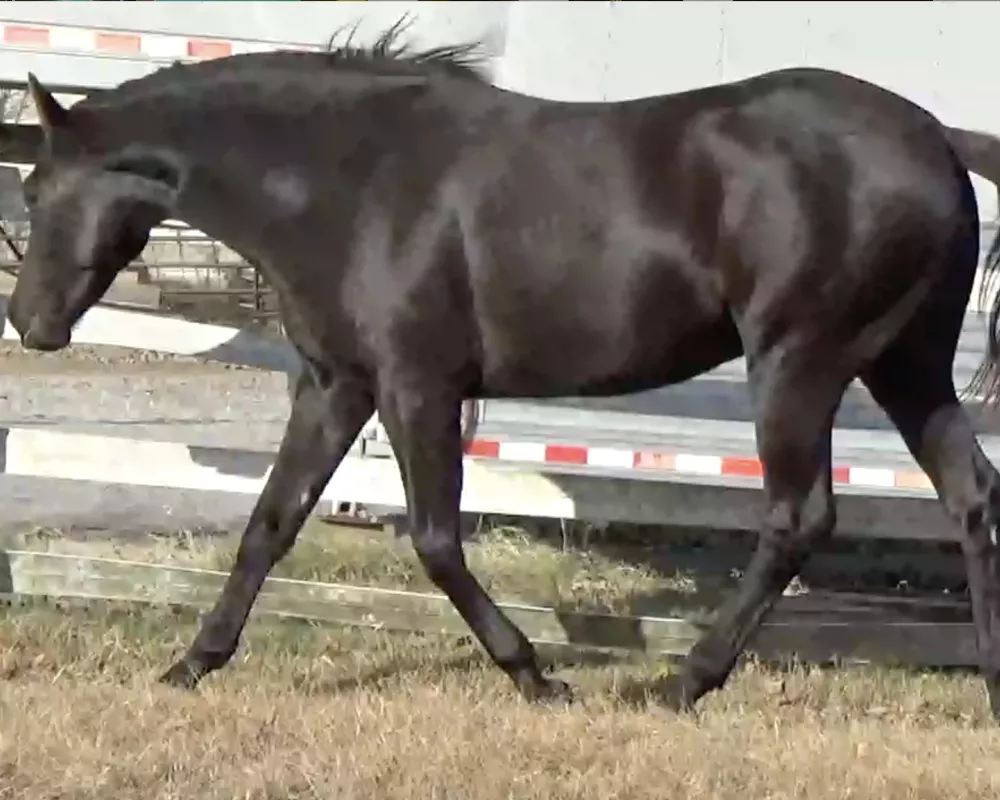Sold
GELDING by EH Buddenbrock who is approved Hannoverian, Oldenburg, Westphalian and Rhineland mares as well as for all Southern German breed associations.Outstanding 2016 GELDING by EH Buddenbrock x Phantasie vom Rappenhof *M* (she is an ATA model mare.) He will be tall and athletic. He has nearly perfect conformation and movement.His ATA reg. name is Sport Royal Quando Quando.https://www.facebook.com/media/set/?vanity=101075659315&set=a.101546480…
Our farm in SE Missouri is out of the way for Sporthorses shoppers but easy to get to for horse transport.So our horses are inexpensive for their high quality.573-703-3150
His sire E.H. Buddenbrock (born1994) is considered one of the best Trakehner stallions in modern history having been named Trakehner stallion of the year in 2010. Buddenbrock is approved as a sire by the Hanoverian, Oldenburg, Westphalian and Rhineland Verbands. He produced more than 200 offspring with earnings in dressage, eventing and jumping; including Grand Prix dressage stallions E.H. King Arthur, E.H. Connery (ridden by Hubertus Schmidt - they were on the German A dressage team and went to the Rio Olympics) and In Flagranti. Buddenbrock is also the grand sire of the sensational stallion E.H.Imperio and many top event horses. Buddenbrock placed and competed in the Bundeschampionat for eventing before being retired to the breeding shed due to his popularity. He is a stallion known for producing highly rideable and athletic horses.
His dam,Phantasie vom Rappenhof*M*competed well through dressage 1st level test 2 with a junior rider/trainer. Phantasie vom Rappenhof scored so high at her studbook inspection she earned the honorable title of Model mare.Gorgeous mover -see inspection report-videos do not do her justice.Phantasie'sgrand sire is sire of champion Seeadler, whose son Bellevue was a leading Trakehner showjumper of the 80s in Germany and whose granddaughter Renaissance Fleur TSF was one of Germany’s most successful Grand Prix horses until her tragic accident in February 2003, which left her with a broken front pastern, ending her competition career. Then premium stallion Coktail, maternal grandsire of Olympic bronze medalist Peron *Pg* and finally Arwetta, one of Germany's best broodmares, multiple show winner at national level and dam of four approved stallions: Arsenal, Aron, E.H. Argument and Argonaut. Argument's son Anthony FRH out of a Hanoverian dam belonged to the top dressage horses in the world and won the team Gold medal at the European Championships in 1998 with rider Isabelle Werth.
At the age of seven, Habicht started a sports career and would later return to breeding duties. Following in the footsteps of his father Burnus AAH, Habicht was offered to the German Olympic Committee, where a competition ensued between the disciplines. Dr. Klimke wanted him as a dressage horse, and German team rider and Olympic medallist Lutz Goessing asked to have him as a show jumper. The event team won out, and Martin Plewa was chosen to be his rider. After six years in the sport, Habicht retired as one of the most successful three-day event horses competing. His international career was, however, hampered by tragedy. Habicht was the top qualifier for the '76 Montreal Olympics, as well as the World Championships in Lexington, Kentucky, in 1978, but was not able to start at either venue. Prior to the '76 Olympics, Plewa was seriously injured in a fall from another horse, and prior to the World Championships, he was involved in a car accident. Plewa credits Habicht with giving him the confidence to compete again after his fall. Together the pair won the acclaimed international three-day event at Achselschwang '77 in the tough mountainous terrain near Munich, and Habicht was the best German horse at the CCI**** in Burghley '76, England. He is the sire of Windfall *Pg*, premium in NMS in 1994, would write history as the world’s most successful eventing stallion later in life.
But the Habicht legacy lives on. His most impressive son,Sixtus became one of the youngest German Elite stallions, based largely on his own performance as an international show jumper and his impact on the breeding scene. His first approved son, EH Buddenbrock was a successful event horse and sire to many outstanding sons, among them the two champion stallions EH King Arthur TSF (Grand Prix dressage) and In Flagranti (FEI dressage), and international performance horses in eventing (** level) and dressage (Grand Prix)
In total eleven Habicht sons were approved, in addition to the above mentioned: Mauritius, Effekt, EH Parforce, Kolumbus, Empire, Markant, Balzflug and Vivus, of which Balzflug and EH Parforce are the most widely known. Balzflug - was also approved by the BWP (Belgian Warmbloed Paard) and was used by the KWPN in the Netherlands, where three of his sons are approved and where he is regarded as a top dressage producer with offspring shining at the Dutch Championships.
EH Parforce made his mark mainly in the jumper ring: He himself was successful up to S level; the most noted among his get is Phantom TSF, in 1998 for the third year in a row number one Trakehner show jumper in Germany (Sixtus was listed # 4). His two daughters ES Banteer TSF and SPS,PS+ES Bunbury TSF (both out of Bachkantate xx by Pasteur xx) were successful CCI*** event horses for Germany and now also excellent brood mares.
Other 'Habichts' whose fame was based 'only' on a sports career: Livius, international show jumper with Anne Kursinki (USA), Dakapo, Pandur, Kyra and Korofino all at highest level jumping, Risiko, Halifax and Aaron at FEI level dressage, Konrad, Avalon and Foray at advanced level eventing.

Tsetserleg has Habicht in his pedigree in the 2nd generation and 4th generation on the other.
Excerpted from Der Trakehner 4-18 issue
“A constant representative on this list of dual progenitors (dressage as well as jumping breeding values lie in the positive range of more than 100 points) is the stallion Habicht and his son Sixtus. The Habicht line is represented via Sixtus by the stallions Axis and his son Hirtentanz as well as the latter’s son Abendtanz plus Kasparow and his son Titulus. By way of Impetus, via the Habicht son Vivus, the blood of the Hörstein sire is again represented, often in connection with Kostolany on the dam’s side (Hirtentanz, Abendtanz and Kasparow) Habicht progeny occupy most of the listings. Friedensfürst, via Lücke and Patmos, is also present with two sons, and Manrico as well as his sire Gipsy King – whose dam line also includes the sport horse producer Grafenstolz – could be found on this list for years. Just like Grafenstolz, El Greco by Fontainbleau was also successful up to the top levels in several disciplines, so it is no surprise that he is represented in the dual progenitor list. El Greco is a half brother on the dam’s side to Enrico Caruso who, by way of his son Kostolany, can be found in the pedigrees of many Trakehners. Here again a genetically anchored dual talent is clearly noticeable in the relatives. Dramatiker by Bardolino represents a further stallion line that possesses much strength and athleticism and emphasizes its many positive breeding values.
How Much Sport Does the Pedigree Hold?
To look a bit deeper at the question of how much dressage and jumping genes are present in today’s Trakehner sport horses, the present article examines the pedigrees and FN data for the stallions Hirtentanz and Imperio which are presently successful in breeding and sport with respect to the passing on of athletic prowess in the first four ancestor generations. An evaluation of the pedigrees of these two stallions, which both descend in a direct line from Habicht, shows interesting results and emphasizes the scientists’ statements.
When studying the numbers shown in Table I it must be noted initially that Hirtentanz as well as Imperio have very sport-oriented pedigrees. The 30 ancestors considered for both stallions each have produced more than 130 upper-level horses which means four to five successful progeny per ancestor. All successful progeny of Imperio’s ancestors as well as those of Hirtentanz have earned an average of around €60,000 (a total of more than €1.5 million), a fact that may possibly be used as a good reason for analyzing a pedigrees for a planned mating.
A review of ancestors having at least one upper-level successful progeny (progeny successful in both disciplines are counted per discipline) shows very clearly why Habicht has such a dominant position in the list of dual progenitors (he produced six upper-level dressage horses, six upper-level jumpers and six upper-level eventers) and shows how such athleticism can be passed on over generations. In Imperio’s case, Connery produced 13 progeny that were successful at upper-levels, Buddenbrock 19, Sixtus nine and Habicht 16. Imperio’s direct paternal ancestors produced a total of 57 progeny that were successful at the upper-levels, eight of them (14%) were successful upper-level jumpers. For Hirtentanz the situation logically is similar (Axis has five progeny at upper-levels, Sixtus has nine, Habicht has 16 and Burnus has 7) since both stallions come from the same line and have Sixtus as well as Habicht in the first generations. Yes, there are differences: Hirtentanz has “only” 37 progeny that are successful at the upper-levels of which, however, 11 (30%) – and thus noticeably more – were successful jumpers. This is interesting because all of Imperio’s ancestors were absolutely, as well as in relation to all upper-level horses, more successful in upper-level jumper events than Hirtentanz’s ancestors. This fact again emphasizes the scientists’ statement that jumper genes can be a positive influence on dressage suitability.
In summary, it can be said that Imperio and Hirtentanz were bred for athleticism across disciplines and demonstrate this athleticism not only by their own performances but they also pass it on reliably through genes that are saturated with athleticism. Accordingly, the upper-level jumper Hirtentanz has himself produced a successful upper-level dressage horse and a jumper, giving him three positive breeding values as the sire of the most successful progeny of all Trakehners in Germany. Imperio, with eight upper-level successful progeny – including two finalists for the seven-year-old world championships – sets accents in his own discipline of dressage, which he himself represents at the international level.
The Dual Progenitor as the Crown of the Breed
A true dual progenitor – and this identifies a stallion who is able to reliably produce top horses for several disciplines -- is the absolute crown of a breed. As a joker that can be used anywhere, such an omnipotent progenitor is very rare and a godsend for any breeder.
Anglo-Arab;Burnus’ most famous son was Habicht, out of the big black mare Hallo, who herself had a very successful career as a sporthorse in north Germany. Habicht was said to be unattractive and lanky as a two year old and barely passed inspection. But he went on to win his 100-day performance test and become one of the best three-day horses Germany has produced in modern times. Two injuries to his rider, Martin Plewe, both unrelated to Habicht, were the only factors that kept him from the 1976 Montreal Olympics and the 1978 World Games in Lexington. They won the CCI*** at Achselschwang and in 1977 were the best German pair at the Burghley CCI****. Habicht died after a freak injury and leg fracture soon after his 25th birthday. He has established a most prominent warmblood eventing dynasty in the world, mainly through his sons Windfall, Sixtus, Parforce, and others. His descendants are known like a mantra in Germany. All sports are represented. The most prominent young dressage horse in Germany until her tragic accident recently, Renaissance Fleur TSF, was a strongly Habicht-influenced descendant. Here in the US, names like Martini, Peron, Livius, Feuertaenzer, Stiletto, Mahon, San Remo, Sonset's Sieger, Sinatra, and many others are familiar.
Habicht was often used as the ideal jumper model in demonstrations in Germany, noted for his perfection in front leg elevation, willingness to jump, and bascule.
"Habicht" won the 1977 Central Stallion Show at Schwaiganger, and came in 1st in the International Three-Day Event at Achselschwang. He achieved numerous other victories and placements in eventing competitons up to the advanced class.
From The Trakehners Strike Back Pt.1 The%20Trakehners%20Strike%20Back:%201%20buddenbrock%20habicht%20axisThe%20Horse%20Magazine
By far the most important among Habicht’s sixteen graded sons is Sixtus. An eye-catching black standing at 16.1 hands, his career started at the grading where he was awarded a premium and was named best jumper of the year. As a six-year-old Sixtus went into training with Gilbert Böckmann who qualified him for the World Young Jumping Horse championships in Zangersheide.
With a total of more than 50 placings in 1.40 metre classes and four wins, Sixtus is something special in the Trakehner breed. His jumping index based on the scores the offspring received at mare inspections, horseshows and gradings is 138 points – no other Trakehner stallion was able to come close to that in the past decade. Sixtus seems to know of his outstanding position – he’s a male diva so to speak.
Sixtus sired Altefled’s Rob Roy who after winning the Bundeschampionat is now on his way to the top in German eventing, already winning regional championships.
Axis is another son of Sixtus who was accepted by the Hannoverian association after finishing a very good performance test in Neustadt/Dosse. This black stallion, who is owned by British pair Sean and Marc Reade of Bluewood Trakehners, was the best jumper of his grading and it was his son Hirtentanz that won this title in 2005 – no doubt this Trakehner is the complete opposite to every prejudice one may have against Trakehners. Not a real beauty this colt jumps like a Holsteiner, the kind of a horse you can easily imagine to meet as “Eurocommerce Hirtentanz” in any class of an international show.
Eventing
Beginning with the lower levels, we have TUPELO (Baron Verdi x Thabana*M*/E.H. Buddenbrock), bred by New Spring Farm and owned and ridden by Maddie McElduff! The pair is competing in the new Modified Division, which is designed to bridge the gap between Training and Preliminary. They ride Dressage Friday at 1:30 pm, and run Cross Country Saturday at 3:58 pm. Good luck!!!!
In the CIC***, we have two Trakehners to watch, TSETSERLEG and BENTLEY'S BEST.
TSETSERLEG*Pg* (Windfall*Pg*E* x Thabana*M*/E.H. Buddenbrock), bred by New Spring Farm, owned by Christine Turner and ridden by Boyd Martin, is better known as Thomas to his fans! The pair enters the Dressage ring at 10:08 am and runs XC Saturday at 2:15 pm! Good luck!!!
For our Canadian fans, we have BENTLEY'S BEST (Hirtentanz x Baronesse XIII/Eichendorf 7), owned by Don Good and ridden by Jessica Phoenix! The pair ride their Dressage on Friday at 12:48 pm and run XC Saturday at 2:55 pm! Good luck!!!
Palma Nigra *E* was ATA Elite and Honour Roll Mare, Gerda Friedrichs Award recipient and Sportshorse Show Overall Grand Champion.
Palma Nigra's dam was German Federal Trakehner Show first prize winner and Verband Premium Mare Passarge II by – Insterruf. Passarge's own dam was Dr. Schilke's famous Verband Elite Mare Palma, the German Reserve Supreme Grand Champion mare, dam of an approved Verband stallion and an Open jumper winner. She is from the great mare family Pelargonie/Trakehnen, one of the most successful ones in the sport, producing Olympic horses like Peron (Dressage Bronze Atlanta) and Partout (member of Dutch dressage Silver team). Palma Nigra herself was only shown once in hand herself and finished up as Trakehner Grand Champion and Show Grand Champion of the Sporthorse Breeders Show 94 Montreal-Blainville, winning the title against a well-known imported Holstein stallion.
Palma was dam of four ATA approved stallions plus two ATA Model mares.
Stallions; Prince of Prussia, Prinz Habicht *Ps*, Platinum vom Rappenhof *Pb*, Patras vom Rappenhof
Mares;Phantasie vom Rappenhof*M*
Piroschka vom Rappenhof *M*, whose daughter Parody (by Guy Laroche,so she is a 3/4 sister of Phantasie)
12 Offspring of Palma Nigra competed with great success, some at highest level. Among them were also two outstanding breeding class horses, Priamos vom Rappenhof, Canadian Triple Crown Supreme Grand Champion in hand, and Paloma vom Rappenhof, Champion Mare of the ATA convention show Columbus, Ohio, both making their mark under saddle as well as dressage champions.
(Sunsprite)Parody*M* show record:through 2nd level USDF recognized shows scores up to 72%
Additional Details
ATA
[1=Bombproof, 10=Hot]

